A queue is a fundamental data structure that follows the First-In-First-Out (FIFO) principle, where elements are added at the rear and removed from the front. It is widely used in various computer science applications such as task scheduling, buffering, and breadth-first search algorithms. Explore the rest of the article to understand how implementing an efficient queue can optimize Your programming projects.
Table of Comparison
| Feature | Queue | Stack |
|---|---|---|
| Definition | Linear data structure that follows First In First Out (FIFO) principle | Linear data structure that follows Last In First Out (LIFO) principle |
| Primary Operations | Enqueue (add), Dequeue (remove) | Push (add), Pop (remove) |
| Use Cases | Task scheduling, buffering, breadth-first search | Function call management, undo mechanisms, depth-first search |
| Access | Access elements in order of arrival | Access most recent element first |
| Implementation | Linked list, array with front/rear pointers | Linked list, array with top pointer |
| Example | Print queue: first document printed first | Browser history: last page visited accessed first |
Introduction to Queues and Stacks
Queues are linear data structures that follow the First-In-First-Out (FIFO) principle, meaning elements are inserted at the rear and removed from the front, making them ideal for scheduling and buffering tasks. Stacks operate on the Last-In-First-Out (LIFO) principle, where elements are added (pushed) and removed (popped) from the top, commonly used in function calls and expression evaluation. Both structures play critical roles in computer science by organizing data access patterns efficiently based on specific application needs.
Definition of a Queue
A queue is a linear data structure that follows the First In, First Out (FIFO) principle, meaning elements are added at the rear and removed from the front. It is commonly used in scenarios such as task scheduling, breadth-first search algorithms, and buffering data streams. Unlike stacks, which use Last In, First Out (LIFO) order, queues maintain the sequence of elements for processing in the exact order they arrive.
Definition of a Stack
A stack is a linear data structure that follows the Last In, First Out (LIFO) principle, meaning the most recently added element is the first to be removed. Common operations on a stack include push (adding an element), pop (removing the top element), and peek (viewing the top element without removal). Stacks are widely used in function call management, expression evaluation, and backtracking algorithms.
Key Features and Properties
A queue operates on a First-In-First-Out (FIFO) principle, ensuring the earliest added element is the first to be removed, ideal for scheduling and buffering tasks. In contrast, a stack follows a Last-In-First-Out (LIFO) approach, where the most recently added element is accessed first, which is essential for recursive algorithms and undo operations. Both data structures support element insertion and removal but differ fundamentally in their access order, affecting their application in computing processes.
Data Structure Operations
Queue operations follow a First-In-First-Out (FIFO) approach, with primary functions including enqueue (insertion at the rear) and dequeue (removal from the front), ensuring ordered processing of elements. Stack operations utilize a Last-In-First-Out (LIFO) method, primarily involving push (insertion at the top) and pop (removal from the top), supporting reverse order access. Both data structures support peek or top operations to view the next element without removal, optimizing task scheduling and memory management.
Use Cases and Applications
Queues excel in scenarios requiring First-In-First-Out (FIFO) processing such as task scheduling, breadth-first search in graphs, and handling asynchronous data streams. Stacks are ideal for Last-In-First-Out (LIFO) operations like recursive function calls, expression evaluation, and backtracking algorithms. These data structures optimize memory management and processing workflows specific to their access patterns in software development and system design.
Performance and Efficiency
Queues offer efficient FIFO (First-In-First-Out) operations ideal for scheduling and buffering tasks, ensuring consistent O(1) time complexity for both enqueue and dequeue in linked list implementations. Stacks provide LIFO (Last-In-First-Out) access with similarly efficient O(1) push and pop operations, optimal for recursive algorithms and expression evaluation. Performance differences emerge in use cases: queues excel in breadth-first search and task management, while stacks favor depth-first search and backtracking, making selection based on algorithmic needs critical for efficiency.
Advantages and Disadvantages
A queue follows a First-In-First-Out (FIFO) principle, allowing efficient processing of tasks in the order they arrive, which is advantageous for scenarios like scheduling and buffering. However, queues can experience delays when processing large volumes as elements must be dequeued sequentially, potentially causing bottlenecks. In contrast, a stack operates on a Last-In-First-Out (LIFO) basis, providing advantages in scenarios like recursive function management and backtracking algorithms, but it risks data loss if not properly managed due to its limited access to only the top element.
Real-World Examples
Queues resemble real-world lines like checkout counters where the first person to arrive is served first, exemplifying the First-In-First-Out (FIFO) principle. Stacks operate similarly to a stack of plates, where the last plate placed on top is the first to be removed, following the Last-In-First-Out (LIFO) approach. In computer science, queues are used in task scheduling and breadth-first search algorithms, while stacks are essential in function call management and depth-first search.
Choosing Between Queue and Stack
Choosing between a queue and a stack depends on the required order of data processing, where stacks follow Last-In-First-Out (LIFO) principles ideal for tasks like undo mechanisms or recursive algorithms. Queues operate on First-In-First-Out (FIFO) principles, making them suitable for scheduling, buffering, and breadth-first search scenarios. Understanding the application's need for data access order and processing sequence is critical for selecting the optimal data structure.
Queue Infographic

 libterm.com
libterm.com